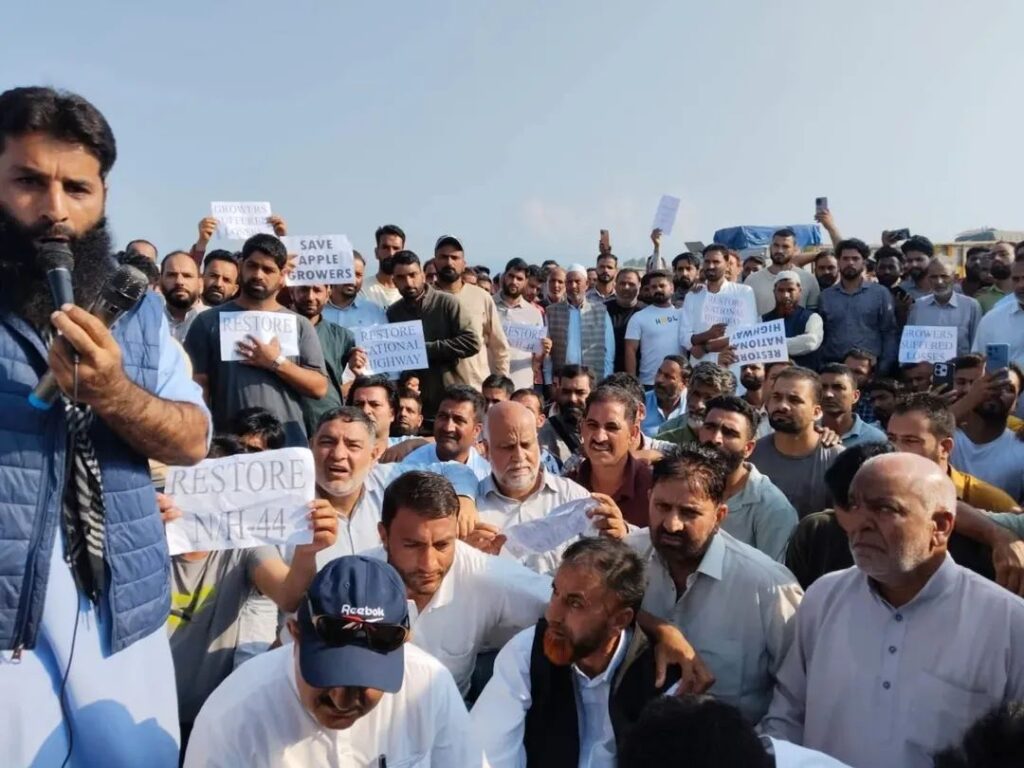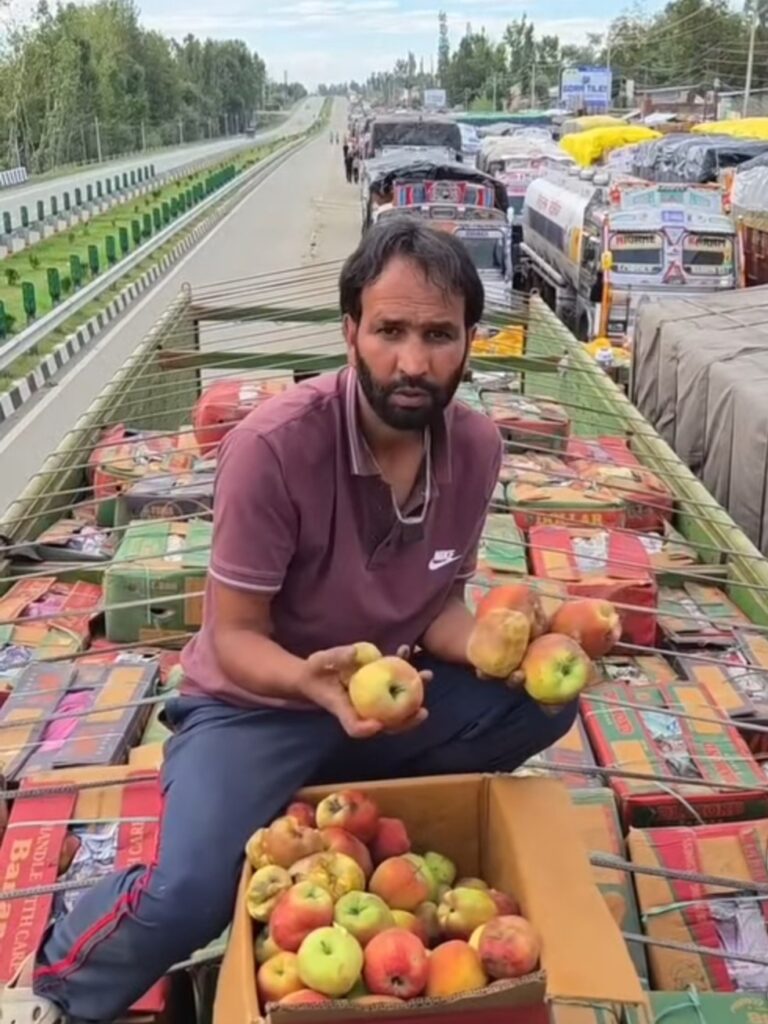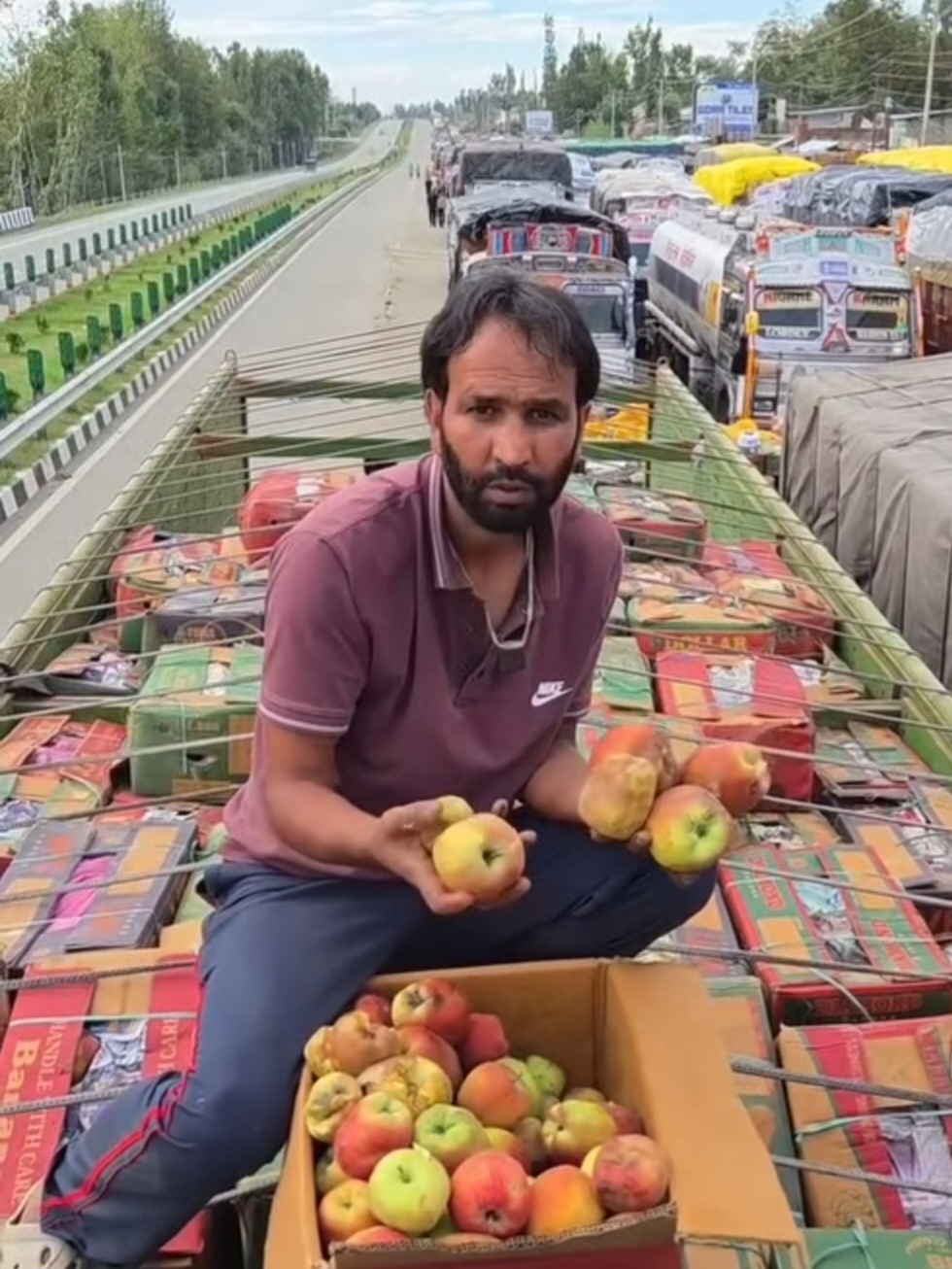Highway blockades and floods push a billion-dollar industry to the brink.
By Ajaz Rashid
Kashmir’s fertile valleys, famed for their lush apple orchards, have for generations formed the economic and social backbone of the region’s rural society. But in September 2025, this heritage stands at a crossroads—a crisis of unprecedented scale, exposing the fragile underpinnings of an industry that supports hundreds of thousands of families and directly shapes the destinies of its youth. The ongoing chaos, triggered by relentless monsoon storms, highway closures, and structural supply chain weaknesses, has elicited a rare consensus in Kashmir: something fundamental must change or the fruit on the edge may finally tip over.
This seasons harvest turned into a disappointment which was supposed to be a year of plenty. Orchard owners and fruit market traders had celebrated a bumper apple crop through the summer. By early September, the valleys of Sopore, Shopian, Baramulla, and Pulwama shimmered with anticipation—a promise of returned investment and renewed optimism after several challenging years. Instead, thousands of truckloads of freshly-picked Kashmiri apples have been stranded along the battered 270-kilometer Srinagar-Jammu highway, the vital artery that connects Kashmir’s orchards to the broader Indian market. More than Rs 10,000 crore (roughly $1.2 billion) worth of produce hung in the balance, rotting inside trucks, mandis, and godowns as the days dragged by and the road remained impassable.
For growers like Bilal Ahmed of Sopore, whose family has nurtured apple orchards for generations, the loss is deeply personal. “We pour our souls into these orchards and are now watching the apples rot helplessly,” he shares. The pain is repeated in every corner of the region, as crates remain unsold and hopes for a prosperous autumn evaporate amid the stench of decaying fruit.

The initial spark for the current crisis occurred in late August when heavy monsoon rains hammered the region, triggering landslides and flash floods along the Srinagar-Jammu highway—especially near Nashri and Udhampur. The only lifeline for transporting apples out of the valley was abruptly snapped. While repairs began, the sheer destruction kept heavy vehicles barred from passage for more than three weeks. Even as light vehicles slowly resumed movement, truckloads of perishable apples languished and spoiled in the heat.
“Apple is a perishable fruit and timely delivery is critical for preserving the quality and getting a reasonable price for the produce,” explained Zahoor Ahmad, President of the Apple Farmers’ Federation during a protest in Kulgam. Each day of delay meant mounting losses. With the harvest season at its peak, not only did the fruit begin to rot, but depressed market confidence sent prices into free-fall: apples worth Rs 1,000 a box were sometimes traded for as little as Rs 100.
In response, the valley’s powerful network of fruit growers and traders staged unusual, valley-wide protests. Fruit mandis in Sopore, Handwara, Shopian, Anantnag, Baramulla, and Ganderbal—a backbone of the trade—closed for two days, pressing for urgent government intervention. With produce worth thousands of crores at risk, tempers flared: “The government has failed to restore the highway. Let them hand over the highway to the Army. We trust our Army to clear it, just as they did after the floods years ago,” declared an agitated orchardist.
Beyond the immediate transport paralysis, longstanding structural problems have exacerbated the disaster. With limited cold storage capacity in the valley, most growers are unable to store harvested apples for long.
The Jammu and Kashmir administration, led by Lieutenant Governor Manoj Sinha, took some initiatives to stem the damage. The launch of a cargo parcel train service from the Nowgam railway station was hailed as an emergency measure, promising to ferry 23–24 tonnes of apples daily to Delhi. But with tens of thousands of tonnes stranded, the stopgap fell far short. Meanwhile, the reopening of the highway to trucks after three weeks finally offered some relief. But by then, 2,000–3,000 truckloads—carrying up to 1.2 million boxes—were already past their best. Financial estimates suggested the losses had soared over Rs 1,000 crore within days, with the prospect of lasting damage to buyers’ trust in the Kashmiri apple brand.
For rural Kashmir, horticulture isn’t just another economic sector; it is the heart of the social fabric. Apple growing alone engages over 3.5 million people, directly or indirectly. Its ripple effects fuel jobs in packaging, transportation, local markets, and support businesses.
Yet, this crisis has brought into stark relief the fragilities that threaten the valley’s youth. Already, unemployment sits at a staggering 17.4 percent, well above the national average. For the over 370,000 job-seeking graduates and postgraduates clocked in this year’s surveys, the closure-induced shock to the apple industry removed one of the few available ladders out of economic inertia. Traditional public sector jobs—long the aspiration of Kashmir’s youth—remain elusive, while the private sector is too small to absorb the overflow. Many young Kashmiris, unable to rely on farming or find meaningful work, must either migrate, turn to precarious gig work, or seek new entrepreneurial frontiers in agriculture and allied sectors.

Larger Questions
The crisis has catalyzed a wider debate in policymaking, civil society, and among the region’s youth. Several hard truths have come to the fore:
- Kashmir’s dependency on a single fragile highway is unsustainable for a region as agriculturally rich and economically intertwined as this.
- Structural investment is desperately needed: modern cold storage, reliable all-weather road and rail connectivity, crop insurance, and a flexible logistics chain that can absorb shocks.
- Policy must focus on making local produce resilient to national and global market fluctuations, taking into account competition from imports and shifting consumption trends.
- The apple crisis, by threatening an entire generation’s confidence in agriculture, risks deepening the problem of youth unemployment and rural migration.
Despite the despair, Kashmir’s apple growers are no strangers to resilience. Across Shopian and Baramulla, families are re-rooting damaged orchards, hoping next season will be kinder. There is growing innovation, with some youth groups launching farm-to-market digital platforms or investing in food processing and value addition. The blossoming of entrepreneurship—evident in thousands of young people eyeing start-up opportunities in agri-tech and tourism—is a visible sign of hope.
Still, for most in the valley, what is needed is not just individual innovation but a system-level shift. The apple, a symbol of Kashmir’s heritage and hardiness, serves as a barometer for the region’s larger economic and social stability.
As autumn deepens and the leaves begin to fall, the ghosts of this season’s harvest will linger. Unless governments—local and central—act with resolve and vision, and invest in infrastructure and market reform, the cycle of crisis will only repeat. And the fruit on the edge may edge finally past the point of return.

Leave a Reply